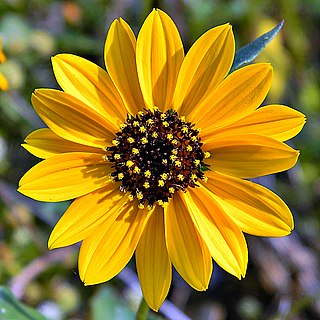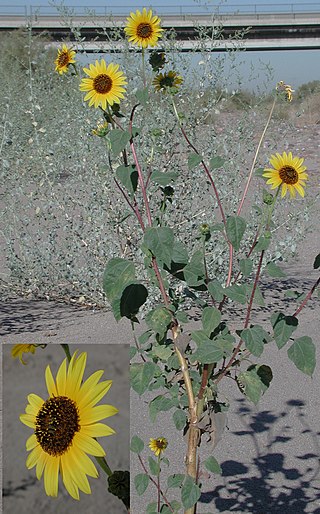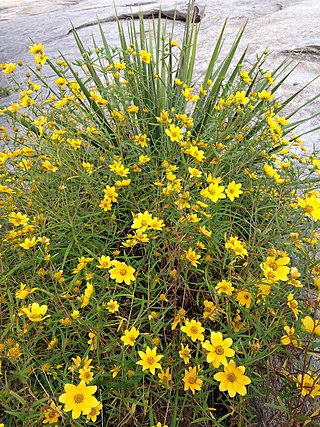
The common sunflower is a species of large annual forb of the genus Helianthus. It is commonly grown as a crop for its edible oily seeds. Apart from cooking oil production, it is also used as livestock forage, as bird food, in some industrial applications, and as an ornamental in domestic gardens. Wild H. annuus is a widely branched annual plant with many flower heads. The domestic sunflower, however, often possesses only a single large inflorescence atop an unbranched stem.
Strawberry-blonde or blond may refer to:

Helianthus is a genus comprising about 70 species of annual and perennial flowering plants in the daisy family Asteraceae commonly known as sunflowers. Except for three South American species, the species of Helianthus are native to North America and Central America. The best-known species is the common sunflower. This and other species, notably Jerusalem artichoke, are cultivated in temperate regions and some tropical regions, as food crops for humans, cattle, and poultry, and as ornamental plants. The species H. annuus typically grows during the summer and into early fall, with the peak growth season being mid-summer.

Helianthus paradoxus, the paradox sunflower, puzzle sunflower or Pecos sunflower, is a threatened species of sunflower found only in west Texas, Utah, and New Mexico salt marshes by the edges of inland salt lakes and salt flats.
Sunflower is the common sunflower, a species of annual flowering plant first domesticated in the Americas.

Perennial sunflower is a crop of sunflowers that are developed by crossing wild perennial and domestic annual sunflower species.

Helianthus giganteus, the giant sunflower or tall sunflower, is a species of Helianthus native to the eastern United States and eastern and central Canada, from Newfoundland west to Alberta south to Minnesota, Mississippi, and South Carolina.
Helianthus niveus is a species of sunflower known by the common names showy sunflower and snowy sunflower. It is native to northern Mexico and the Southwestern United States.

Helianthus microcephalus is a perennial species of Helianthus also known as small woodland sunflower or small-wood sunflower or small-head sunflower or simply as woodland sunflower. It is a native of Northern America, and is to be found growing in open woodlands and along roadsides. It is a host plant for the American painted lady, painted lady, and spring azure butterflies. It is also a larval host plant for the silvery checkerspot butterfly.
H. petiolaris may refer to:
H. giganteus may refer to:

Helianthus petiolaris is a North American plant species in the family Asteraceae, commonly known as the prairie sunflower or lesser sunflower. Naturalist and botanist Thomas Nuttall was the first to describe the prairie sunflower in 1821. The word petiolaris in Latin means, “having a petiole”. The species originated in Western United States, but has since expanded east. The prairie sunflower is sometimes considered a weed.

Helianthus debilis is a species of sunflower known by the common names cucumberleaf sunflower, beach sunflower, weak sunflower, and East Coast dune sunflower. It is native to the United States, where it can be found along the Atlantic and Gulf Coasts. It is known elsewhere as an introduced species, such as South Africa, Australia, Taiwan, Slovakia, and Cuba.

Helianthus anomalus, the western sunflower, is a species of plants in the family Asteraceae, found in the southwestern United States.
Western sunflower is a common name for several plants and may refer to:
Little sunflower is a common name for several plants and may refer to:

Helianthus strumosus, the pale-leaf woodland sunflower, is a species of sunflower native to North America east of the Great Plains and is in the family Asteraceae. It is a native perennial sunflower that resembles other members of this family including the Pale Sunflower, Woodland Sunflower, Hispid Sunflower, and Jerusalem Artichoke. Pale-leaf sunflowers can be found in a diverse range of habitats including woodland areas, prairies, and meadows, providing that these habitats have access to partial sun.

Helianthus porteri is a species of sunflower known by the common names Porter's sunflower, Stone Mountain daisy and Confederate daisy. The term "daisy" is imprecise because the species is a sunflower (Helianthus) rather than a daisy. Likewise, although the plant grows on Stone Mountain, GA, its range extends well beyond. The connection to the Confederacy is through Stone Mountain which contains a confederate monument, although the connection is tenuous as the species was named before the Civil War in 1849 by Harvard botanist Asa Gray in honor of Thomas Conrad Porter, a Pennsylvanian minister and botanist who collected the plant in Georgia. Gray initially named the plant Rudbeckia porteri, later changed to Helianthus in 1998 by John F. Pruski.

Charles Bixler Heiser Jr. (1920–2010) was a professor of botany, known as a leading expert on the sunflower genus Helianthus. He is also noteworthy as the author of a "series of popular books that did much to promote botany to the general public."
This page is based on this
Wikipedia article Text is available under the
CC BY-SA 4.0 license; additional terms may apply.
Images, videos and audio are available under their respective licenses.










